Sir John Monash, Personal Files Book 3, 11 April - 26 April 1915, Part 1
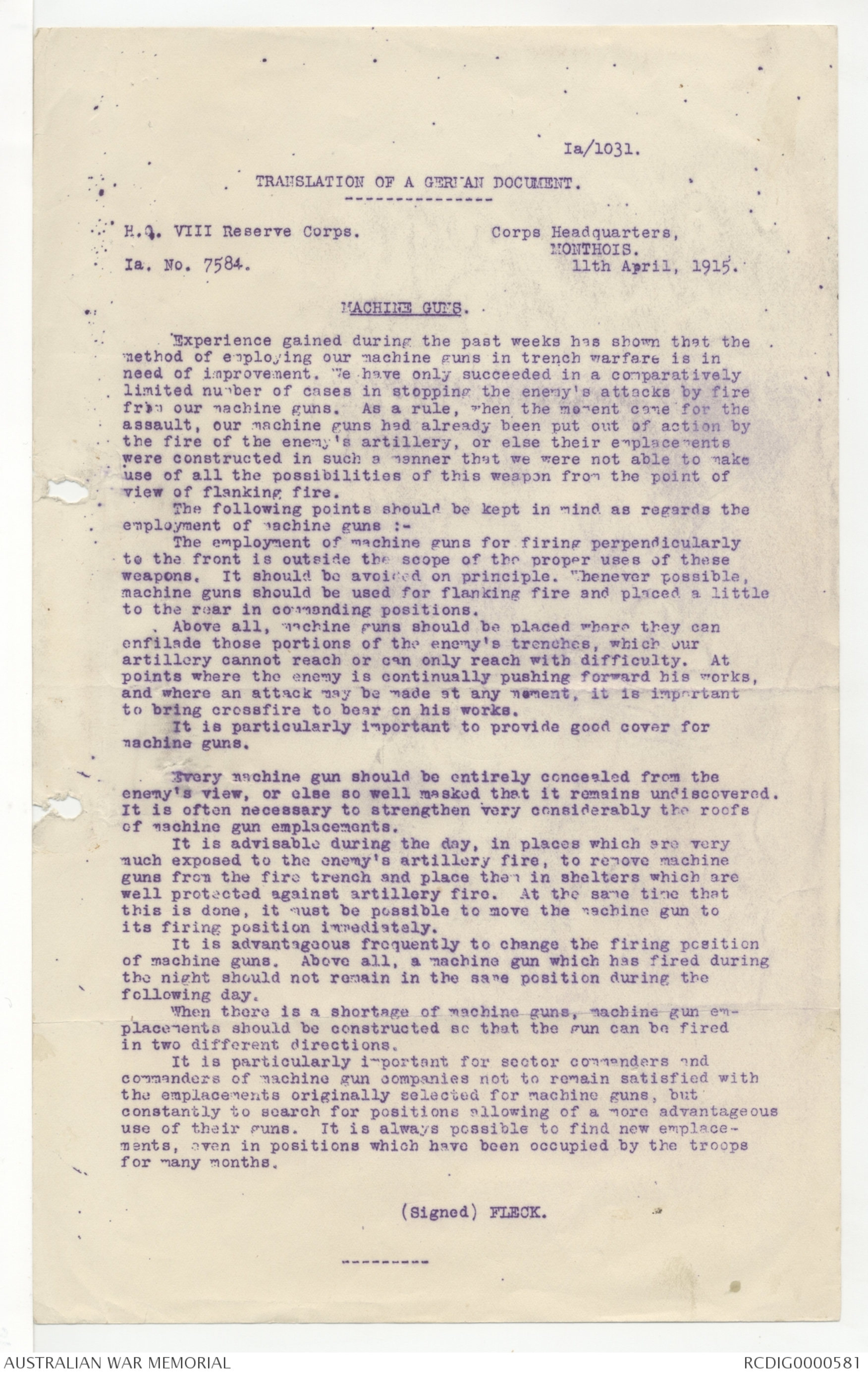
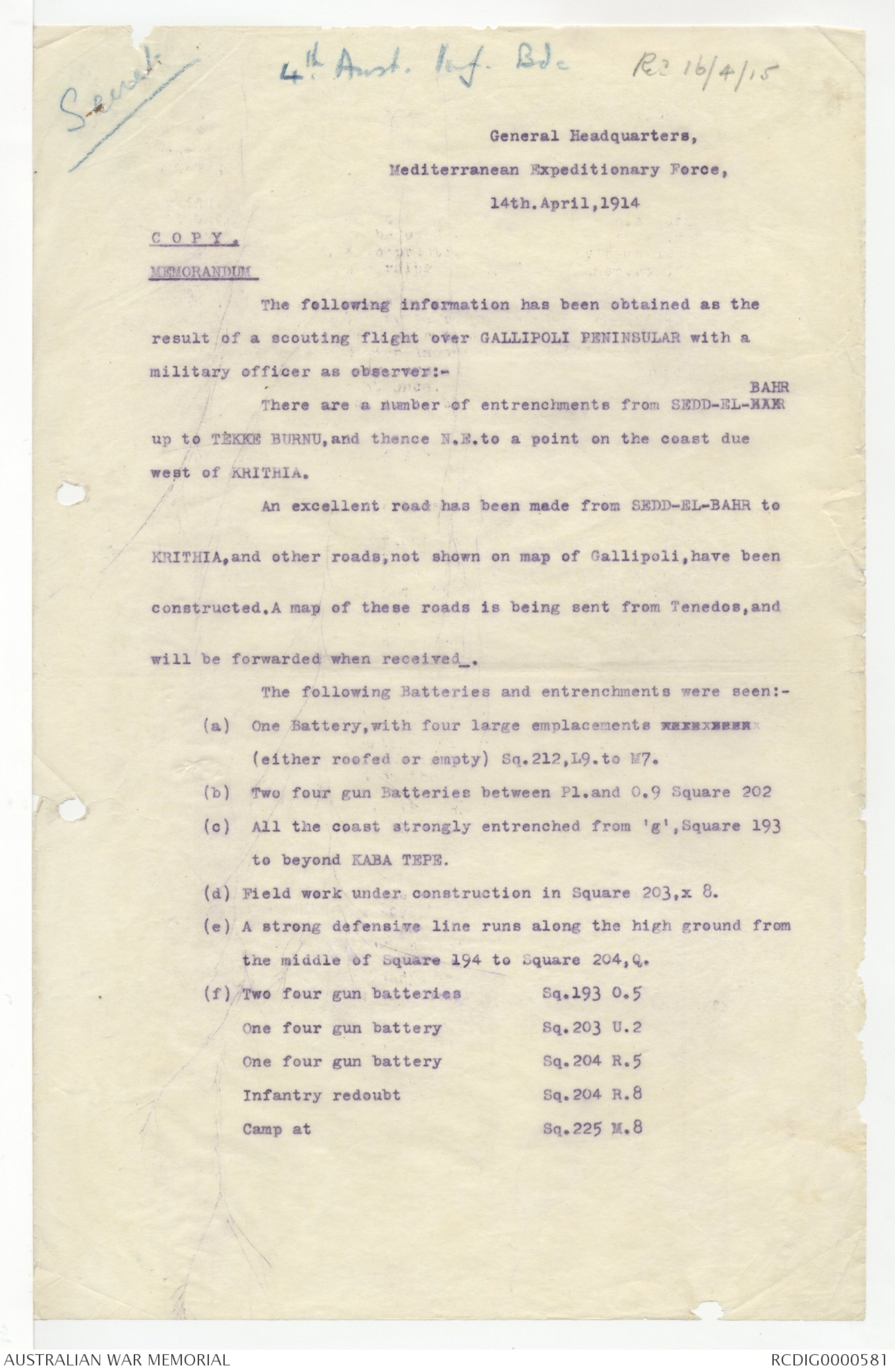
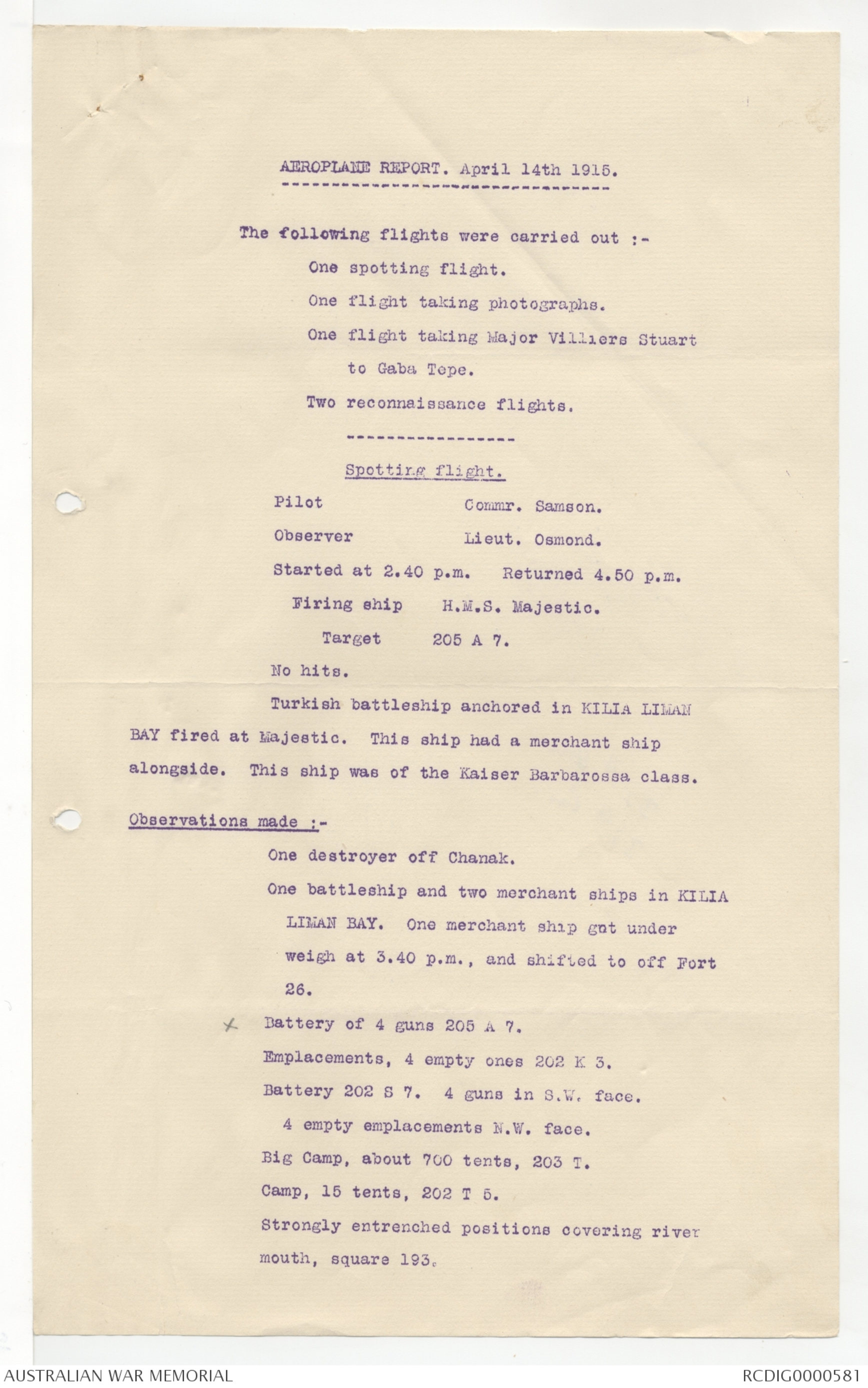
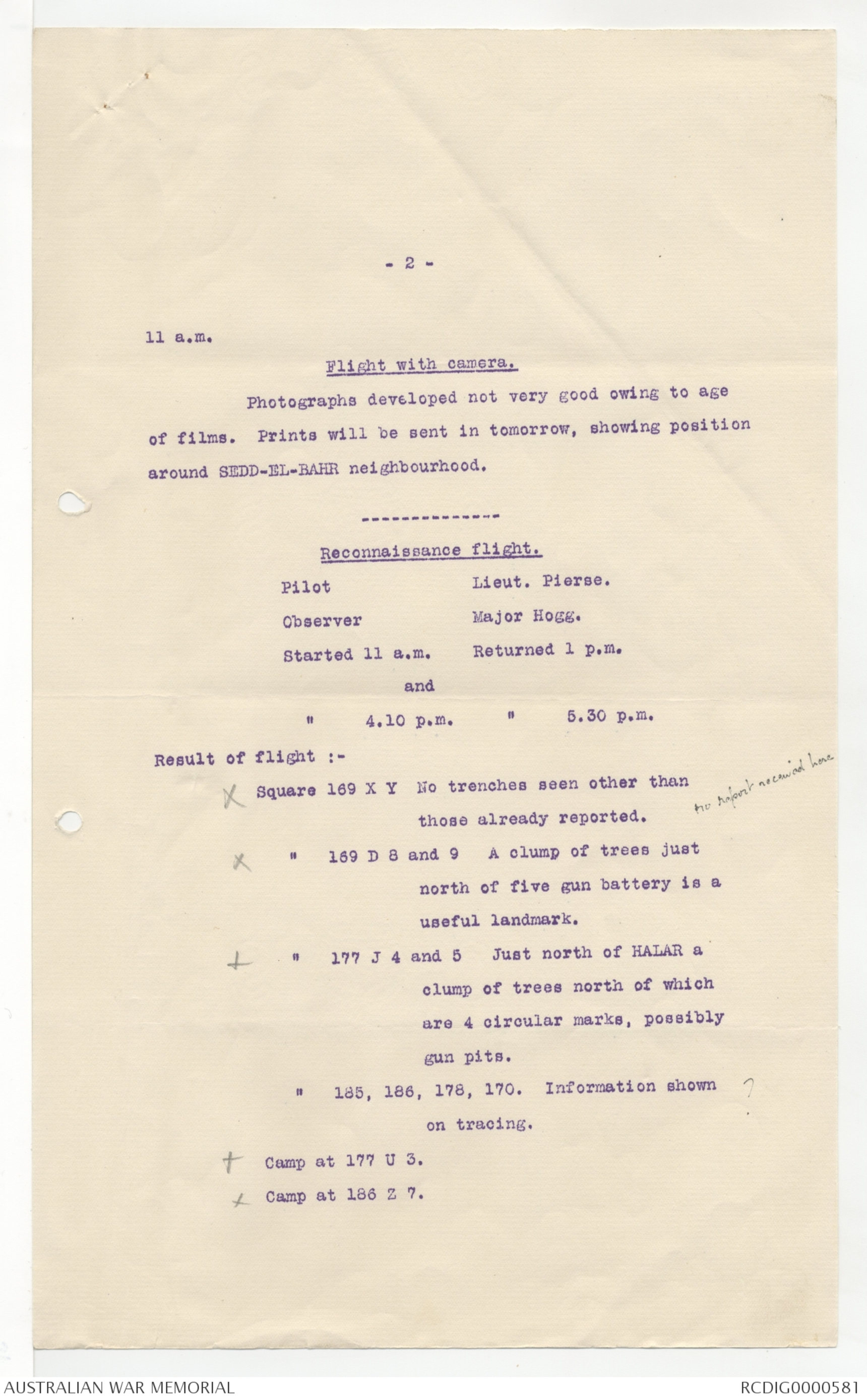
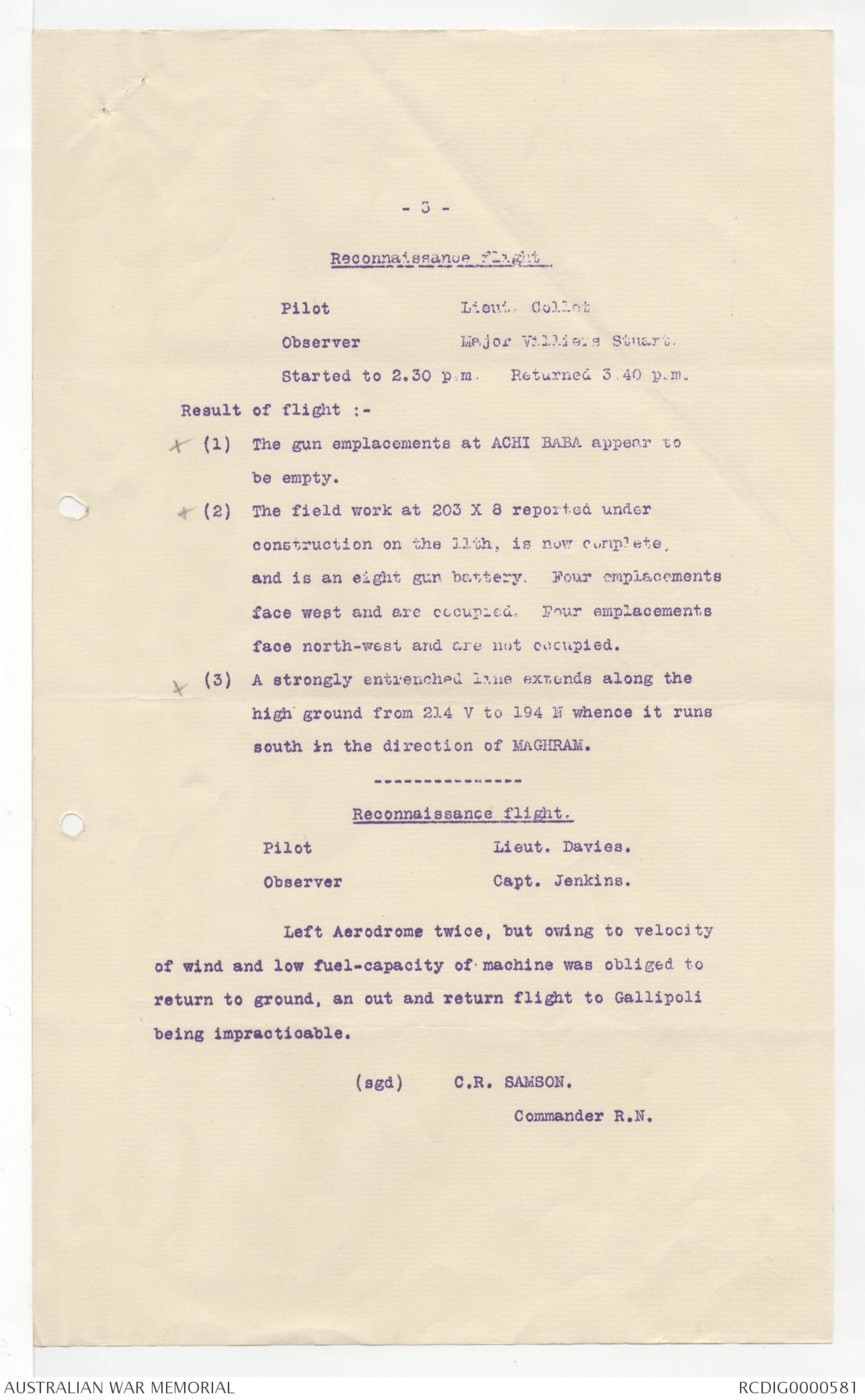
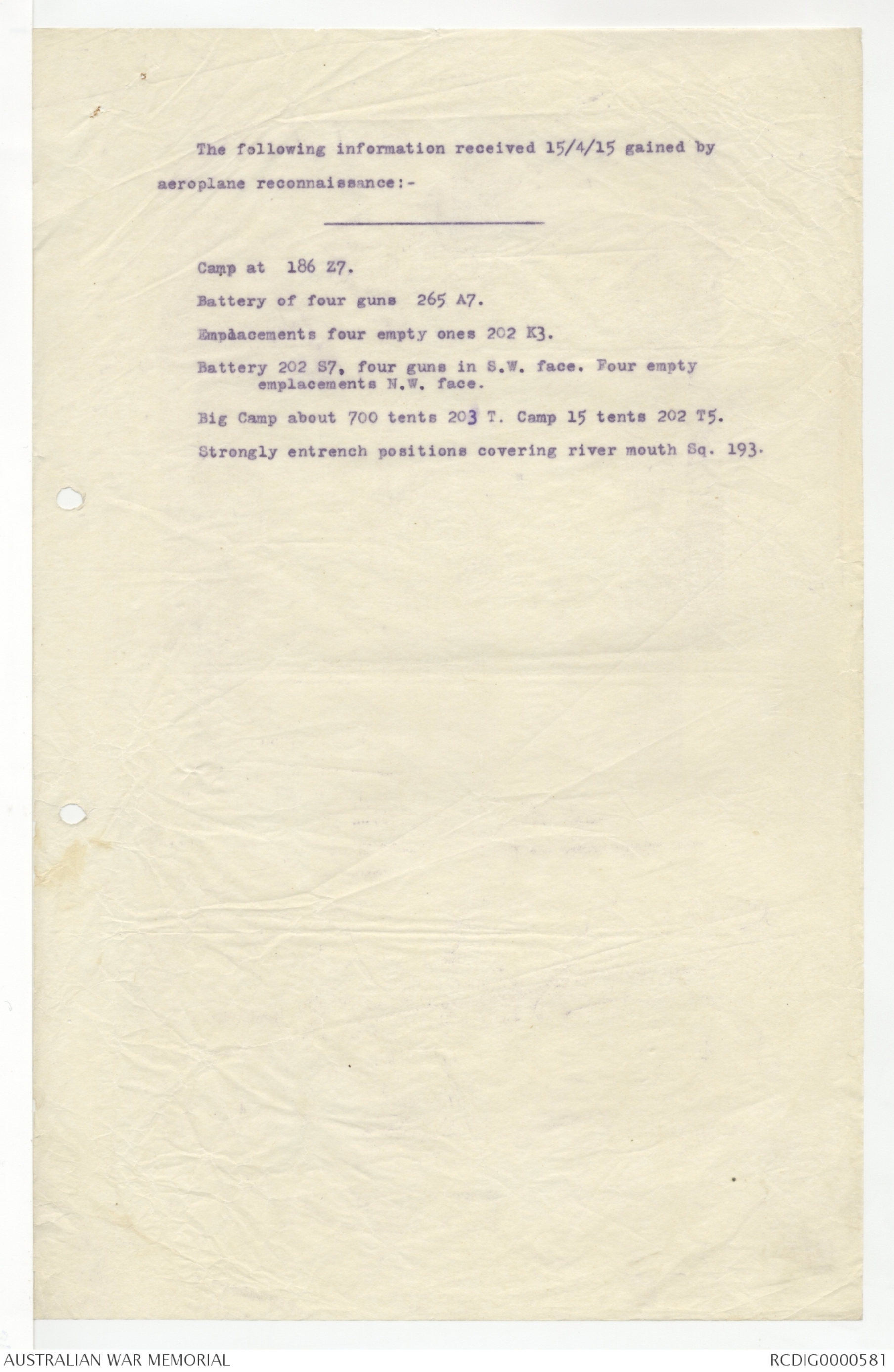
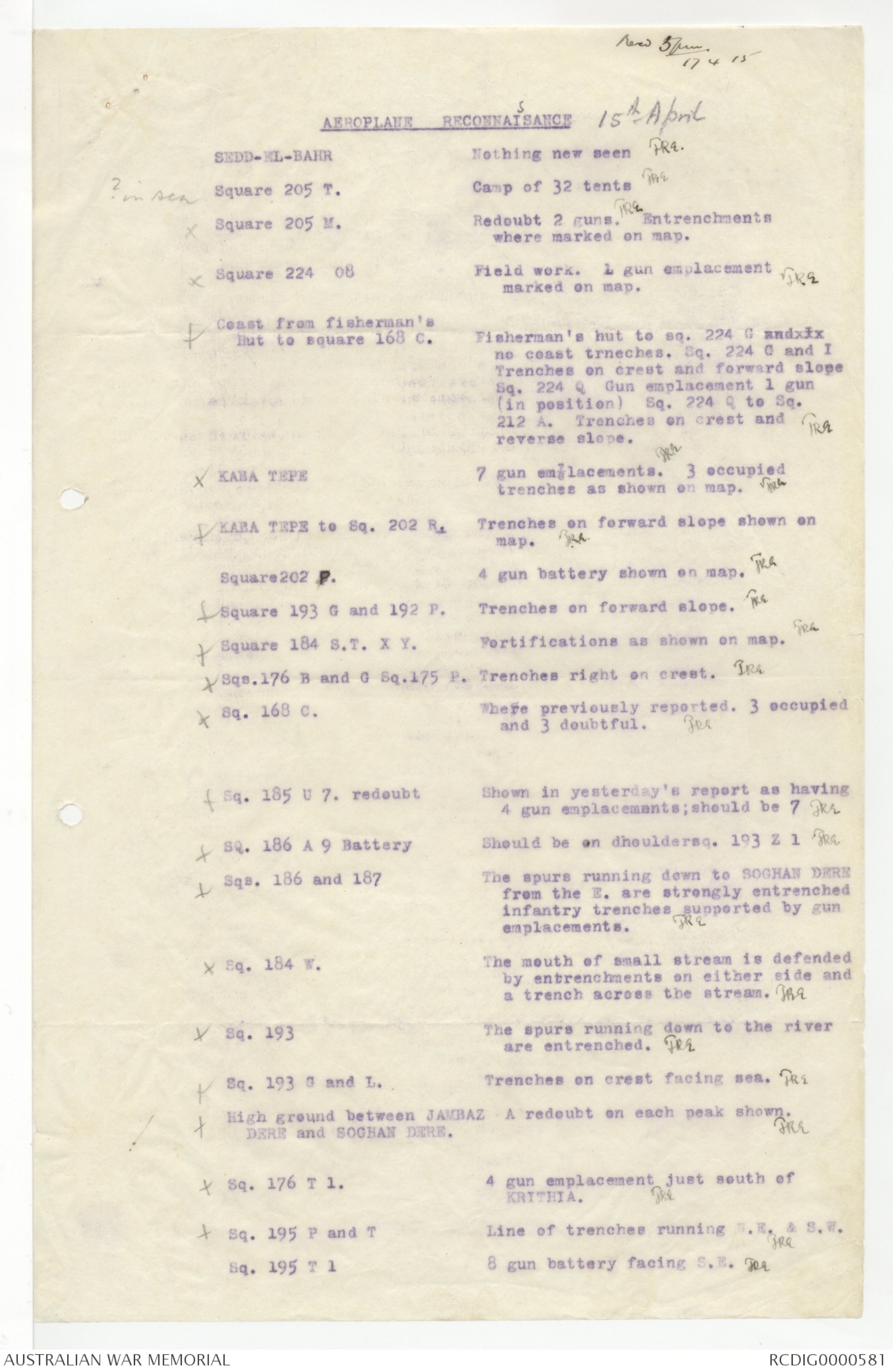
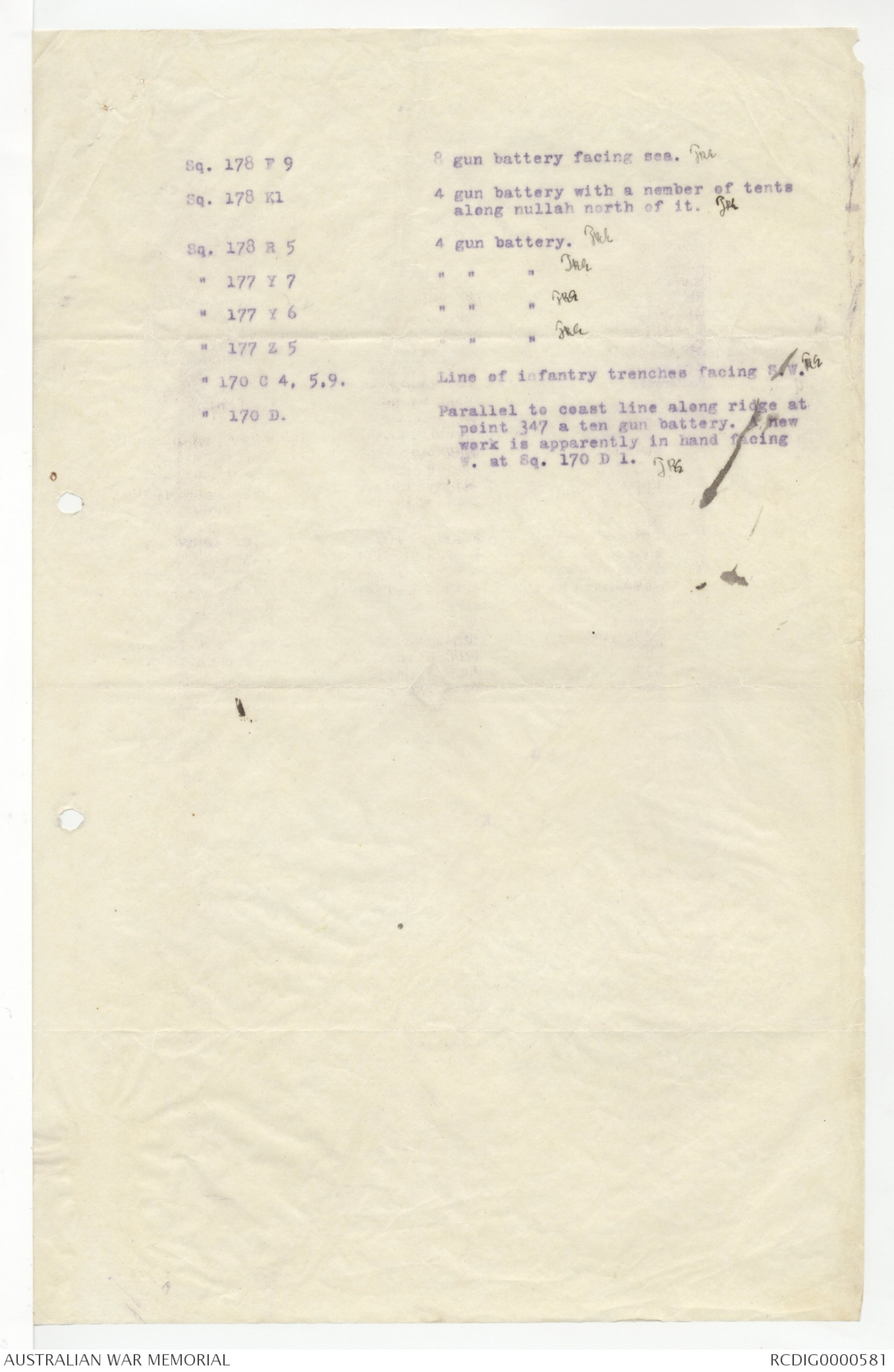
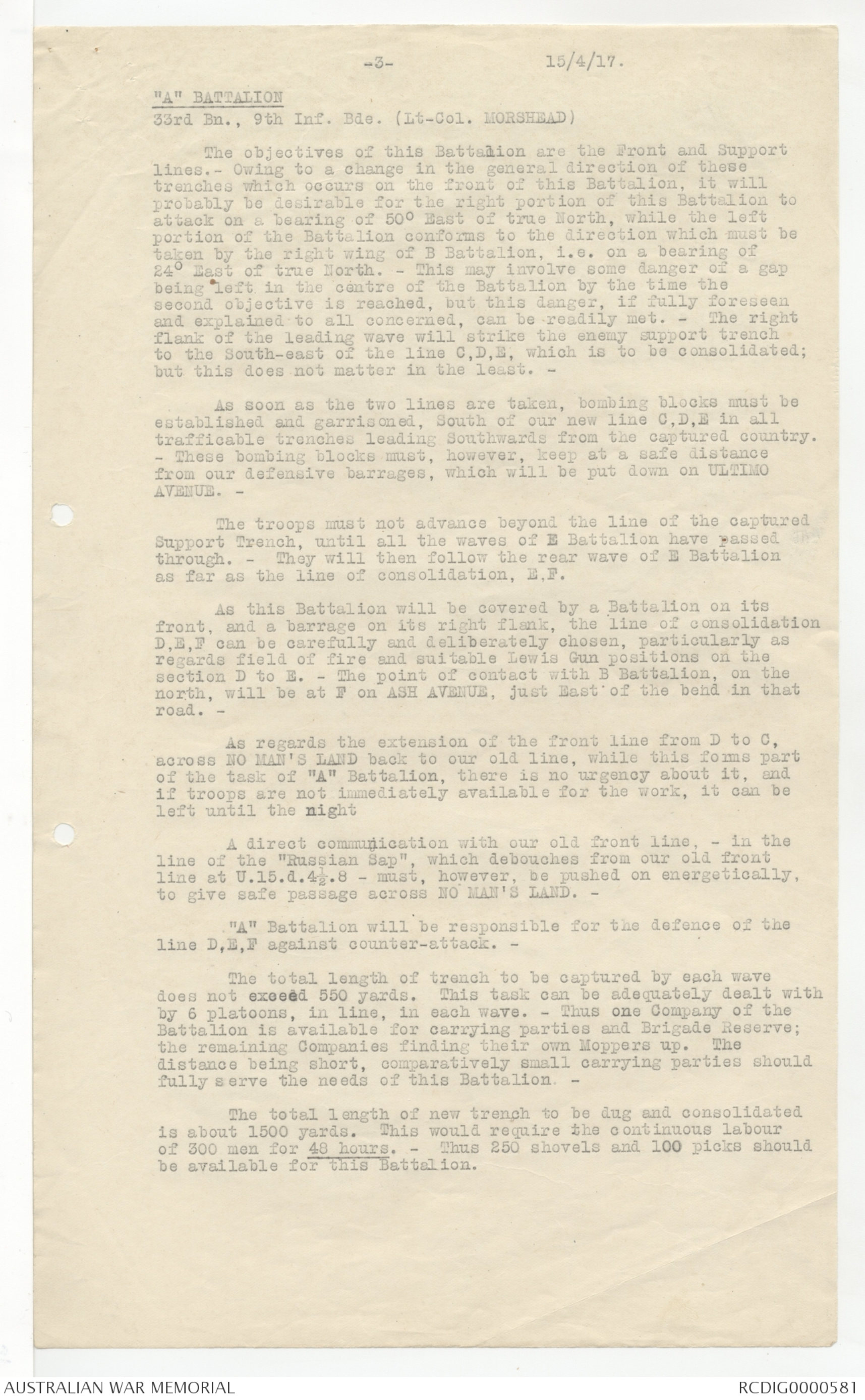
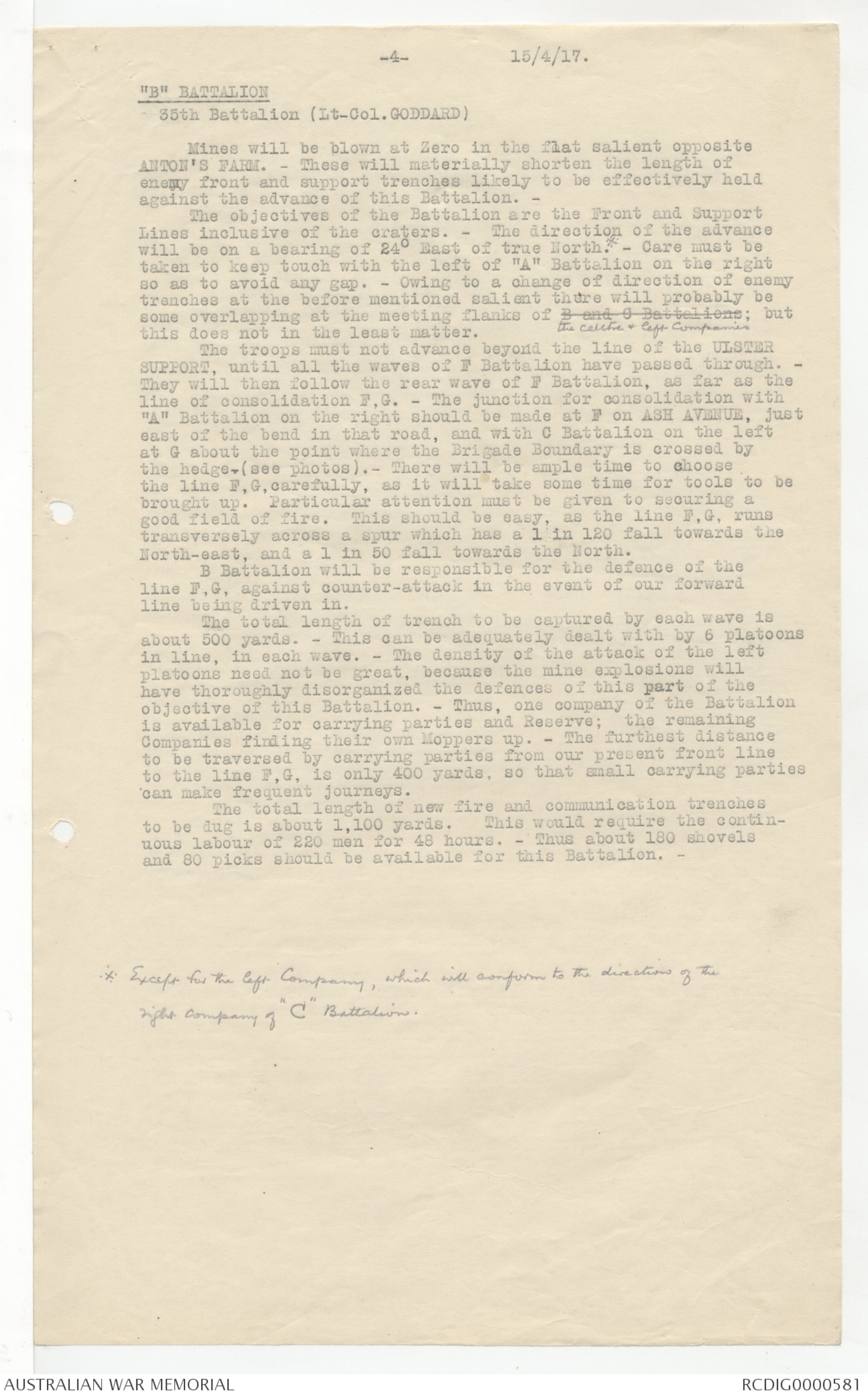
Ia/1031.
TRANSLATION OF A GERMAN DOCUMENT.
--------
H.Q. VIII Reserve Corps. Corps Headquarters,
MONTHOIS.
Ia. No. 7584. 11th April, 1915.
MACHINE GUNS.
Experience gained during the past weeks has shown that the
method of employing our machine guns in trench warfare is in
need of improvement. We have only succeeded in a comparatively
limited number of cases in stopping the enemy's attacks by fire
from our machine guns. As a rule, when the moment came for the
assault, our machine guns had already been put out of action by
the fire of the enemy's artillery, or else their emplacements
were constructed in such a manner that we were not able to make
use of all the possibilities of this weapon from the point of
view of flanking fire.
The following points should be kept in mind as regards the
employment of machine guns :-
The employment of machine guns for firing perpendicularly
to the front is outside the scope of the proper uses of these
weapons. It should be avoided on principle. Whenever possible
machine guns should be used for flanking fire and placed a little
to the rear in commanding positions.
Above all, machine guns should be placed where they can
enfilade those portions of the enemy's trenches, which our
artillery cannot reach or can only reach with difficulty. At
points where the enemy is continually pushing forward his works,
and where an attack may be made at any moment, it is important
to bring crossfire to bear on his works.
It is particularly important to provide good cover for
machine guns.
Every machine gun should be entirely concealed from the
enemy's view, or else so well masked that it remains undiscovered.
It is often necessary to strengthen very considerably the roofs
of machine gun emplacements.
It is advisable during the day, in places which are very
much exposed to the enemy’s artillery fire, to remove machine
guns from the fire trench and place them in shelters which are
well protected against artillery fire. At the same time that
this is done, it must be possible to move the machine gun to
its firing position immediately .
It is advantageous frequently to change the firing position
of machine guns. Above all, a machine gun which has fired during
the night should not remain in the same position during the
following day.
When there is a shortage of machine guns, machine gun em-
placements should be constructed so that the gun can be fired
in two different directions.
It is particularly important for sector commanders and
commanders of machine gun companies not to remain satisfied with
the emplacements originally selected for machine guns, but
constantly to search for positions allowing of a more advantageous
use of their guns. It is always possible to find new emplacements,
even in positions which have been occupied by the troops
for many months.
(Signed) FLECK.
---------
Secret
4th Aust. Inf. Bd. Rec 16/4/15
General Headquarters,
Mediterranean Expeditionary Force,
14th. April, 1914
C O P Y
MEMORANDUM
The following information has been obtained as the
result of a scouting flight over GALLIPOLI PENINSULAR with a
military officer as observer:-
BAHR
There are a number of entrenchments from SEDD-EL-XXX BAHR
up to TEKKE BURNU, and thence N.E.to a point on the coast due
west of KRITHIA.
An excellent road has been made from SEDD-EL-BAHR to
KRITHIA, and ether roads net shown on map of Gallipoli, have been
constructed. A map of these roads is being sent from Tenedos, and
will be forwarded when received_.
The following Batteries and entrenchments were seen:-
(a) One Battery, with four large emplacements waxnxzss
(either roofed or empty) Sq.212,L9.to M7.
[b) Two four gun Batteries between P1. and O.9 Square 202
(c) All the coast strongly entrenched from 'g', Square 193
to beyond KABA TEPE.
(d) Field work under construction in Square 203,x 8.
(e) A strong defensive line runs along the high ground from
the middle of Square 194 to Square 204,Q.
(f) Two four gun batteries Sq. 193 0.5
One four gun battery Sq. 203 U.2
One four gun battery Sq.204 R.5
Infantry redoubt Sq. 204 R.8
Camp at Sq.225 M.8
AEROPLANE REPORT. April 14th 1915.
-------------
The following flights were carried out :-
One spotting flight.
One flight taking photographs.
One flight taking Major Villiers Stuart
to Gaba Tepe.
Two reconnaissance flights.
----------
Spotting flight.
Pilot Commr. Samson.
Observer Lieut. Osmond.
Started at 2.40 p.m. Returned 4.50 p.m.
Firing ship H.M.S. Majestic.
Target 205 A 7.
No hits.
Turkish battleship anchored in KILIA LIMAN
BAY fired at Majestic. This ship had a merchant ship
alongside. This ship was of the Kaiser Barbarossa class.
Observations made: -
One destroyer off Chanak.
One battleship and two merchant ships in KILIA
LIMAN BAY. One merchant ship got under
weigh at 3.40 p.m., and shifted to off Fort
26.
x Battery of 4 guns 205 A 7.
Emplacements, 4 empty ones 202 K 3.
Battery 202 S 7. 4 guns in S.W. face.
4 empty emplacements N.W. face.
Big Camp, about 700 tents, 203 T.
Camp, 15 tents, 202 T 5.
Strongly entrenched positions covering river
mouth, square 193.
- 2 -
11 a.m.
Flight with camera.
Photographs developed not very good owing to age
of films. Prints will be sent in tomorrow, showing position
around SEDD-EL-BAHR neighbourhood.
----------
Reconnaissance flight.
Pilot Lieut. Pierse.
Observer Major Hogg.
Started 11 a.m. Returned 1 p.m.
and
" 4.10 p.m. " 6.30 p.m.
Result of flight :-
X Square 169 X Y No trenches seen other than
those already reported. No report received here
X " 169 D 8 and 9 A clump of trees just
north of five gun battery is a
useful landmark.
X " 177 J 4 and 5 Just north of HALAR a
clump of trees north of which
are 4 circular marks, possibly
gun pits.
" 185, 188, 178, 170. Information shown
on tracing.
X Camp at 177 U 3.
X Camp at 186 Z 7.
- 3 -
Reconnaissance flight.
Pilot Lieut. Collet
Observer Major Villiers Stuart.
Started to 2.30 p.m. Returned 3.40 p.m.
Result of flight :-
X (1) The gun emplacements at ACHI BABA appear to
be empty.
X (2)The field work at 203 X 8 reported under
construction on the 11th, is now complete,
and is an eight gun battery. Four emplacements
face west and are occupied. Four emplacements
face north-west and are not occupied.
X (3) A strongly entrenched line extends along the
high ground from 214 V to 194 N whence it runs
south in the direction of MAGHRAM.
--------------
Reconnaissance flight.
Pilot Lieut. Davies.
Observer Capt. Jenkins.
Left Aerodrome twice, but owing to velocity
of wind and low fuel-capacity of machine was obliged to
return to ground, an out and return flight to Gallipoli
being impracticable.
(sgd) C.R. SAMSON.
Commander R.N.
The following information received 15/4/15 gained by
aeroplane reconnaissance:-
—————
Camp at 186 Z7.
Battery of four guns 265 A7.
Emplacements four empty ones 202 K3.
Battery 202 S7, four guns in S.W. face. Four empty
emplacements N.W. face.
Big Camp about 700 tents 203 T. Camp 15 tents 202 T5.
Strongly entrench positions covering river mouth Sq. 193.
New 5pm
17 4 15
AEROPLANE RECONNAISSANCE 15th April
SEDD-EL-BAHR Nothing new seen TRE.
? in sea Square 205 T. Camp of 32 tents TRE
X Square 205 M. Redoubt 2 guns. TRE Entrenchments
where marked on map.
X Square 224 08 Field work. 1 gun emplacement
marked on map. TRE
X Coast from fisherman's
hut to square 168 C. Fisherman's hut to sq. 224 G andxxxx
no coast trneches. Sq. 224 C and I
Trenches on crest and forward slope
Sq. 224 Q Gun emplacement 1 gun
(in position) Sq. 224 Q to Sq.
212 A. Trenches on crest and
reverse slope. TRE
X KABA TEPE 7 gun emplacements. TRE 3 occupied
trenches as shown on map. TRE
X KABA TEPE to Sq. 202 R. Trenches on forward slope shown on
map. TRE
Square 202 F. 4 gun battery shown on map. TRE
X Square 193 G and 192 F Trenches on forward slope. TRE
X Square 184 S.T. X Y. Fortifications as shown on map. TRE
X Sqs.176 B and G Sc.175 P. Trenches right on crest. TRE
X Sq. 168 C. Where previously reported. 3 occupied
and 3 doubtful. TRE
X Sq. 185 U 7. redoubt Shown in yesterday's report as having
4 gun emplacements: should be 7 TRE
X Sq. 186 A 9 Battery Should be on Dhouldersq. 193 Z 1 TRE
X Sq. 186 and 187 The spurs running down to SOGHAN DERE
from the E. are strongly entrenched
infantry trenches supported by gun
emplacements. TRE
X SQ. 184 W. The mouth of small stream is defended
by entrenchments on either side and
a trench across the stream. TRE
X Sq. 193 The spurs running down to the river
are entrenched. TRE
X Sq. 193 G and L. Trenches on crest facing sea. TRE
X High ground between JAWBAZ A redoubt on each peak shown.
DERE and SOCHAN DERE. TRE
X Sq. 176 T 1. 4 gun emplacement just south of
KRITHIA. TRE
X Sq. 195 P and T Line of trenches running S.E. & S.W.
TRE
X Sq. 195 T 1 8 gun battery facing S.E. TRE
Sq. 178 F 9 8 gun battery facing sea. TRE
Sq. 178 K1 4 gun battery with a number of tents
along nullah north of it. TRE
Sq. 178 R 5 4 gun battery. TRE
" 177 Y7 '" " " tre
" 177 Y6 '" " " tre
" 177 Z5 '" " " tre
" 170 C4, 5, 9. Line of infantry trenches facing S.W. TRE
" 170 D. Parallel to coast line along ridge at
point 347 a ten gun battery. A new
work is apparently in hand facing
W. at Sq. 170 D 1. TRE
-3- 15/4/17.
"A" BATTALION
33rd Bn., 9th Inf. Bds (Lt-Col. MORSHEAD)
The objectives of this Battalion are the Front and Support
lines. - Owing to a change in the general direction of these
trenches which occurs on the front of this Battalion. It will
probably be desirable for the right portion of this Battalion to
attack on a bearing of 50o East of true North, while the left
portion of this Battalion conforms to the direction which must be
taken by the right wing of B Battalion. i.e. on a bearing of
24o East of true North. - This may involve some danger of a gap
being left in the centre of the Battalion by the time the
second objective is reached, but this danger, if fully foreseen
and explained to all concerned, can be readily met. - The right
flank of the leading wave will strike the enemy support trench
to the south-east of the line C,D,E, which is to be consolidated;
but this does not matter in the least. -
As soon as the two lines are taken, bombing blocks must be
established and garrisoned, South of our new line C,D,E in all
trafficable trenches leading Southwards from the captured country.
- These bombing blocks must, however, keep at a safe distance
from our defensive barrages, which will be put down on ULTIMO
AVENUE. -
The troops must not advance beyond the line of the captured
Support Trench, until all the waves of E Battalion have passed
through. - They will then follow the rear wave of E Battalion
as far as the line of consolidation, E.F.
As this Battalion will be covered by a Battalion on its
front, and a barrage on its right flank, the line of consolidation
D,E,F can be carefully and deliberately chosen, particularly as
regards field of fire and suitable Lewis Gun positions on the
section D to E. - The point of contact with B Battalion, on the
north, will be at F on ASH AVENUE, just East of the bend in that
road. -
As regards the extension of the front line from D to C,
across NO MAN'S LAND back to our old line, while this forms part
of the task of "A" Battalion, there is no urgency about it, and
if troops are not immediately available for the work, it can be
left until the night
A direct communication with our old front line, - in the
line of the "Russian Sap", which debouches from our old front
line at U.15.1.4½.8 - must, however, be pushed on energetically
to give safe passage across NO MAN'S LAND. -
"A" Battalion will be responsible for the defence of the
line D,E,F against counter-attack.
The total length of trench to be captured by each wave
does not exceed 550 yards. This task can be adequately dealt with
by 6 platoons, in line, in each wave. -Thus one Company of the
Battalion is available for carrying parties and Brigade Reserve;
the remaining Companies finding their own Moppers up. The
distance being short, comparatively small carrying parties should
fully serve the needs of this Battalion. -
The total length of new trench to be dug and consolidated
is about 1500 yards. This would require the continuous labour
of 300 men for 48 hours. - Thus 250 shovels and 100 picks should
be available for this Battalion.
-4- 15/4/17.
"B" BATTALION
35th Battalion (Lt-Col. GODDARD)
Mines will be blown at Zero in the flat salient opposite
ANTON'S FARM. - These will materially shorten the length of
enemy front and support trenches likely to be effectively held
against the advance of this Battalion. -
The objectives of the Battalion are the Front and Support
Lines inclusive of the craters. - The direction of the advance
will be on a bearing of 24o East of true North.* - Care must be
taken to keep touch with the left if "A" Battalion on the right
so as to avoid any gap. - Owing to a change of direction of enemy
trenches at the before mentioned salient there will probably be
some overlapping at the meeting flanks of the centre & left
Companies B and C Battalions; but this does not in the least matter.
The Troops must not advance beyond the line of the ULSTER
SUPPORT, until all the waves of F Battalion have passed through. -
They will then follow the rear wave of F Battalion, as far as the
line of consolidation F,G. - The junction for consolidation with
"A" Battalion on the right should be made a F on ASH AVENUE, just
east of the bend in that road, and with C Battalion on the left
at G about the point where the Brigade Boundary is crossed by
the hedge, (see photos). - There will be ample time to choose
the line F,G carefully, as it will take some time for tools to be
brought up. Particular attention must be given to securing a
good field of fire. This should be easy, as the line F,G, runs
transversely across a spur which has a 1 in 120 fall towards the
North-east, and a 1 in 50 fall towards the North.
B Battalion will be responsible for the defence of the
line F,G, against counter-attack in the event of our forward
line being driven in.
The total length of trench to be captured by each wave is
about 500 yards. - This can be adequately dealt with by 6 platoons
in line, in each wave. - The density of the attack of the left
platoons need not be great, because the mine explosions will
have thoroughly disorganized the defences of this part of the
objective of this Battalion. - Thus, one company of the Battalion
is available for carrying parties and Reserve; the remaining
Companies finding their own Moppers up. - The furthest distance
to be traversed by carrying parties from our present front line
to the line F,G, is only 400 yards, so that small carrying parties
can make frequent journeys.
The total length of new fire and communication trenches
to be dug is about 1,100 yards. This would require the continuous
labour of 220 men for 48 hours. - Thus about 180 shovels
and 80 picks should be available for this Battalion. -
* Except for the left Company, which will conform to the directions of the
right company of "C" Battalion.
 Jacqueline Kennedy
Jacqueline KennedyThis transcription item is now locked to you for editing. To release the lock either Save your changes or Cancel.
This lock will be automatically released after 60 minutes of inactivity.